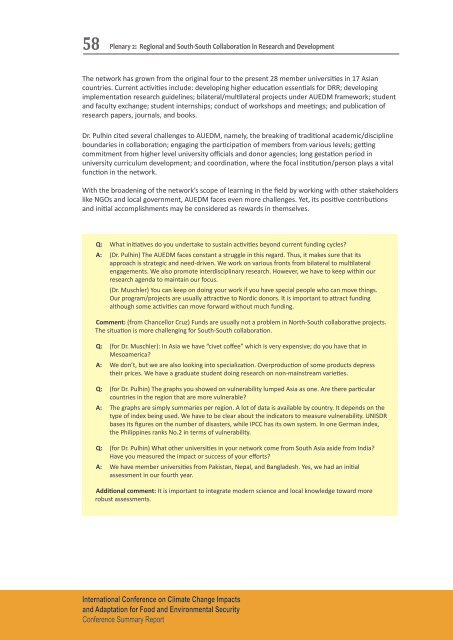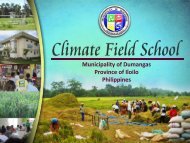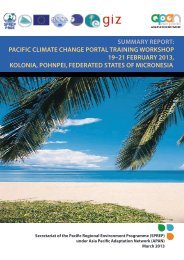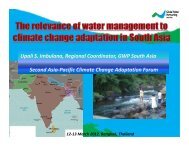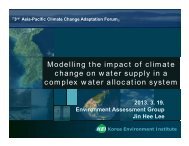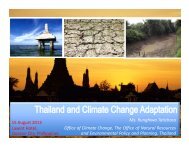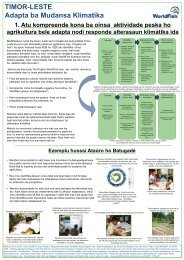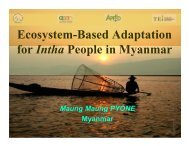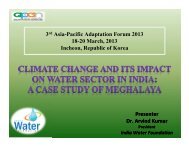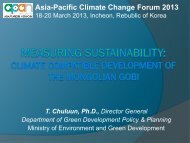PDF file (2.44 MB) - Asia Pacific Adaptation Network
PDF file (2.44 MB) - Asia Pacific Adaptation Network
PDF file (2.44 MB) - Asia Pacific Adaptation Network
Create successful ePaper yourself
Turn your PDF publications into a flip-book with our unique Google optimized e-Paper software.
58Plenary 2: Regional and South-South Collaboration in Research and DevelopmentThe network has grown from the original four to the present 28 member universities in 17 <strong>Asia</strong>ncountries. Current activities include: developing higher education essentials for DRR; developingimplementation research guidelines; bilateral/multilateral projects under AUEDM framework; studentand faculty exchange; student internships; conduct of workshops and meetings; and publication ofresearch papers, journals, and books.Dr. Pulhin cited several challenges to AUEDM, namely, the breaking of traditional academic/disciplineboundaries in collaboration; engaging the participation of members from various levels; gettingcommitment from higher level university officials and donor agencies; long gestation period inuniversity curriculum development; and coordination, where the focal institution/person plays a vitalfunction in the network.With the broadening of the network’s scope of learning in the field by working with other stakeholderslike NGOs and local government, AUEDM faces even more challenges. Yet, its positive contributionsand initial accomplishments may be considered as rewards in themselves.Q: What initiatives do you undertake to sustain activities beyond current funding cycles?A: (Dr. Pulhin) The AUEDM faces constant a struggle in this regard. Thus, it makes sure that itsapproach is strategic and need-driven. We work on various fronts from bilateral to multilateralengagements. We also promote interdisciplinary research. However, we have to keep within ourresearch agenda to maintain our focus.(Dr. Muschler) You can keep on doing your work if you have special people who can move things.Our program/projects are usually attractive to Nordic donors. It is important to attract fundingalthough some activities can move forward without much funding.Comment: (from Chancellor Cruz) Funds are usually not a problem in North-South collaborative projects.The situation is more challenging for South-South collaboration.Q: (for Dr. Muschler): In <strong>Asia</strong> we have “civet coffee” which is very expensive; do you have that inMesoamerica?A: We don’t, but we are also looking into specialization. Overproduction of some products depresstheir prices. We have a graduate student doing research on non-mainstream varieties.Q: (for Dr. Pulhin) The graphs you showed on vulnerability lumped <strong>Asia</strong> as one. Are there particularcountries in the region that are more vulnerable?A: The graphs are simply summaries per region. A lot of data is available by country. It depends on thetype of index being used. We have to be clear about the indicators to measure vulnerability. UNISDRbases its figures on the number of disasters, while IPCC has its own system. In one German index,the Philippines ranks No.2 in terms of vulnerability.Q: (for Dr. Pulhin) What other universities in your network come from South <strong>Asia</strong> aside from India?Have you measured the impact or success of your efforts?A: We have member universities from Pakistan, Nepal, and Bangladesh. Yes, we had an initialassessment in our fourth year.Additional comment: It is important to integrate modern science and local knowledge toward morerobust assessments.International Conference on Climate Change Impactsand <strong>Adaptation</strong> for Food and Environmental SecurityConference Summary Report


